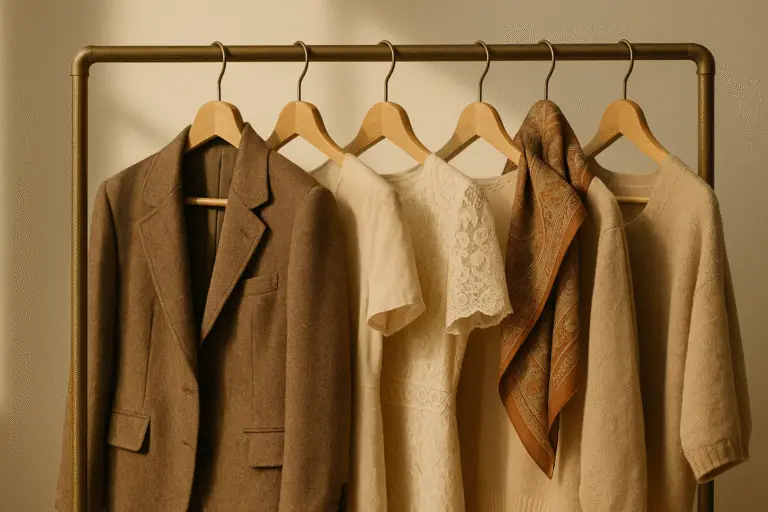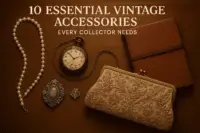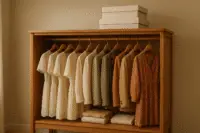When shopping for vintage clothing, finding high-quality items can be tricky. Here’s a quick guide to help you identify the best pieces:
- Check Labels and Tags: Look for clues like “Made in USA” labels, union tags, or vintage sizing information to confirm the garment’s age and origin.
- Inspect Construction: High-quality vintage items often have metal zippers, hand-sewn details, and durable seams like French seams or pinked edges.
- Examine Fabric: Natural materials like wool, cotton, silk, and linen were commonly used in older garments and tend to age well.
- Assess Damage: Look for stains, holes, or fading. While some flaws can be fixed, severe wear might not be worth the effort.
- Research Brand and Rarity: Designer labels, unique designs, and limited-edition pieces often hold more value. Compare market prices to avoid overpaying.
What Vintage Clothing Can Teach Us About Real Quality * Fashion Deep Dive *
Check Labels and Tags for Age Clues
Labels on vintage clothing are like little time machines – they offer hints about when a garment was made. By carefully examining these markers, you can identify authentic vintage pieces and estimate their age more accurately.
Find Age Markers on Clothing Labels
- “Made in USA” tags: These are often found on garments produced in the 1970s or earlier.
- ILGWU union tags: The International Ladies’ Garment Workers’ Union (ILGWU) tags changed designs over the years. Their variations can help pinpoint the decade of production.
- Lot tags or numbers: Manufacturers used these to track garment batches until 1979, meaning items with lot tags were likely made before the 1980s.
- The Woolmark logo: Introduced in 1964, this logo has been updated over time. Its design can help date wool garments starting from the mid-1960s.
- Brand names and logos: Changes in branding – like shifts from elegant script fonts to more modern typography – can signal different time periods.
Spot Features Found Only in Vintage Items
- Label construction: Older garments often have woven labels, common in the early to mid-20th century. Printed satin labels, on the other hand, became popular around the 1960s.
- Sizing information: Vintage sizing differs from today’s standards. For instance, a British size 14 in the 1940s corresponded to a 32-inch bust, while by the late 1960s, it had increased to 36 inches. Labels that include “to fit bust” measurements are typically from before the 1980s.
- Paper tags: These often provide era-specific details, such as fabric types, washing instructions, and sizing. They can further confirm a garment’s authenticity.
Next, take a closer look at the craftsmanship to evaluate the quality of the piece.
Check How the Garment is Made
Once you’ve gathered clues from the label, the next step is to inspect how the garment is constructed. This can reveal a lot about its quality and authenticity, especially when it comes to vintage pieces.
Look at Hardware and Seam Work
Pay close attention to the hardware and seams. For instance, metal zippers – especially heavy ones – are a hallmark of vintage quality. Unlike modern plastic alternatives, these zippers feel solid and should still glide smoothly, even after years of use.
Buttons are another giveaway. Vintage garments often feature buttons made from materials like mother-of-pearl, bakelite, or carved wood. These buttons are not only durable but also crafted with precision. You might even find extra buttons tucked inside seams or attached to care labels – a thoughtful touch that reflects the manufacturing standards of the time.
Seams also tell a story. Look for techniques like French seams or pinked edges, which are designed to enclose raw edges and prevent fraying. These details indicate a commitment to durability and craftsmanship.
Additionally, hand-finished touches are a strong sign of quality. Check for hand-sewn buttonholes and blind hems, which often point to the work of skilled seamstresses from an era when clothing was made to stand the test of time.
Once you’ve evaluated the construction, shift your focus to the fabric – it should match the garment’s overall quality.
Test the Fabric Type
Vintage clothing tends to rely on natural fibers, which were the standard at the time. Materials like pure wool, cotton, silk, and linen were commonly used, and they each have unique characteristics that can help you identify authenticity.
- Cotton: Vintage cotton feels heavier and has a tighter, more durable weave compared to modern cotton fabrics.
- Wool: Often blended with silk or cotton, vintage wool is high-quality and resists pilling. When you gently stretch it, it should feel both soft and structured, with a slight elasticity that hints at its resilience.
- Silk: Genuine vintage silk has a natural sheen and a fluid drape that synthetic fabrics struggle to mimic. It may also have a slightly uneven texture due to older manufacturing methods. It should feel cool and weighty in your hands.
- Patterns and Prints: Vintage fabrics often feature intricate weaves or detailed prints, created with specialized techniques. Look for subtle color variations or natural fading, which can indicate authentic aging rather than modern distressing.
If you’re unsure about the fabric’s integrity, try gently stretching a small section. It should spring back into shape, showing that the material is still in good condition. These details, combined with the garment’s construction, can help you spot a genuine vintage piece.
Look for Damage and Wear Patterns
Take a close look at the garment’s condition. Knowing how to identify damage and wear patterns can help you decide if a vintage piece is worth buying and how much effort it may need to restore or maintain.
Find Common Types of Damage
Stains are one of the most obvious issues to spot. Pay attention to areas prone to staining, like underarms, necklines, cuffs, and hemlines. Some stains, especially those caused by sweat or food, may have set permanently over time. To catch discoloration that might not be obvious under store lighting, hold the garment up to natural light.
Color fading can tell a story about the garment’s past. Look for uneven fading, which might suggest improper storage or prolonged exposure to sunlight. Fading along fold lines often means the piece was stored folded for years. While mild fading can enhance a vintage garment’s charm, heavy fading can detract from its appearance and value.
Holes and tears need careful inspection. Tiny moth holes in wool are common, but they can worsen over time. Feel the fabric for weak spots that could turn into holes, and gently stretch sections to test the material’s strength. Vintage fabric in good condition should have some flexibility without feeling overly delicate or making crackling noises. Pay special attention to high-stress areas like pocket corners, buttonholes, and seams.
Previous repairs can provide insight into the garment’s history. Look for patches, darning, or reweaving. While repairs aren’t necessarily a negative, they should be evaluated. Well-done repairs can even show that someone valued the piece enough to preserve it, which might enhance its story and appeal.
After identifying any damage, look for signs that the garment has been cared for properly. These details can reveal a lot about its overall condition.
Check for Good Care Signs
After assessing damage, shift your focus to signs of proper care. Intact linings are a great indicator. A lining that’s well-preserved and securely attached suggests the garment hasn’t been subjected to harsh cleaning methods or excessive wear.
Strong seams are another positive sign. Examine the seam allowances to ensure they’re not fraying or pulling apart. Tight, secure seams indicate both quality craftsmanship and careful handling over the years.
Look for evidence of professional maintenance. Garments that smell neutral or fresh and have minimal wrinkles often reflect proper care. Be wary of pieces with strong odors like mothballs, mildew, or smoke, as these smells can be tough – or even impossible – to remove.
Check for original details like buttons, belt loops, and decorative trims. If these elements are intact, it’s a good sign the garment hasn’t been heavily altered or neglected. While missing pieces can sometimes be replaced, original components add authenticity and value.
Lastly, the presence of care instructions or dry cleaning tags can signal that previous owners followed proper maintenance routines. These small details often align with better overall condition and longer garment life.
Confirm the Time Period and Origin
Once you’ve assessed the garment’s condition, the next step is to determine its time period and origin. This not only helps confirm its authenticity but also adds to its historical significance.
Use Tags to Date the Item
After verifying the garment’s condition, identifying its origin is key to solidifying its authenticity.
Union labels, like those from the ILGWU, can provide valuable clues about when and where the garment was made. Similarly, care tags – especially the language used on them – can help pinpoint the era of production.
Country labels are another reliable indicator of origin. Look for phrases such as “Made in U.S.A.”, “Made in England”, “Made in France”, or “Made in Mexico.” On many vintage pieces, this information is prominently displayed on the brand tag. Even labels with outdated or former country names can serve as a confirmation of authenticity.
Don’t forget to examine metal zippers, as they often have country stamps that can further verify the garment’s origin.
Determine Worth and How Rare the Item Is
After confirming authenticity and assessing the condition, the next step is to weigh a piece’s rarity and the strength of its brand. This helps determine whether you’re holding a hidden gem or simply a well-preserved garment.
Look at Brand Name and Design Details
Designer labels from iconic periods often fetch higher prices. But don’t dismiss mid-tier brands that have developed cult followings, like Gunne Sax or early Ralph Lauren collections. These can hold significant value, too.
Pay attention to unique design features – think hand-sewn beadwork, intricate embroidery, or other standout elements. Limited-edition items or pieces tied to specific collections can also command higher prices. For example, a garment from Vivienne Westwood’s early punk collections or an original band tour t-shirt from the 1970s or 1980s carries both historical and monetary value.
The brand’s reputation, distinct design details, and intact original features, especially when crafted from natural fabrics, are all critical markers of worth. Additionally, documentation or provenance can further validate the value of a vintage piece.
Once you’ve assessed these factors, the next step is to compare your findings with actual market data.
Compare with Similar Sales
After identifying the standout characteristics of your piece, thorough research can help you determine its market value and rarity. Focus on completed sales rather than active listings. Why? Because completed sales reflect what buyers are willing to pay, while current listings often reflect sellers’ aspirations.
Auction results are particularly valuable for high-end vintage items. Renowned auction houses like Christie’s and Sotheby’s, along with specialized vintage auction platforms, maintain detailed records of sale prices. These benchmarks can help you gauge the value of designer pieces and rare finds.
For a wider view, resources like AllVintageStyles offer detailed guides on vintage brands and styles from various decades. These guides provide historical context and highlight key characteristics, making it easier to verify authenticity and understand why certain pieces stand out.
Finally, consider how current fashion trends might influence demand. Vintage styles that echo contemporary trends, such as 1990s minimalism, 1980s power suits, or 1970s bohemian looks, often see a surge in popularity and value. Fashion is cyclical, and pieces that align with today’s trends can command higher prices.
Conclusion: 5 Key Methods for Finding Quality Vintage Pieces
Vintage treasures are often defined by their craftsmanship, attention to detail, and authenticity. Building a collection of these timeless pieces becomes much simpler when you know exactly what to look for. These five methods work together to help you identify genuine finds and avoid less desirable options.
Start by examining labels and tags. Details like union labels, care instructions, and fabric composition provide clues about a piece’s era and origin. These are your first tools for spotting reproductions and understanding the history of what you’re buying.
Pay attention to construction details. Quality vintage items often feature sturdy seams, natural fabrics, and hardware like metal zippers – all signs of durability. The weight of the fabric and the precision of the stitching can instantly indicate whether a piece was built to last.
Next, assess any damage. Be realistic about flaws. Issues like missing buttons or light stains can often be repaired, but structural problems like fabric deterioration or torn seams may not be worth the investment. Pieces that smell clean and show intact original features often signal they’ve been well cared for.
Use era and origin markers to verify authenticity. Compare label details to historical fashion timelines and look for construction techniques typical of the period. This step helps ensure you’re purchasing pieces from the era you’re targeting, not modern reproductions.
Lastly, research rarity and market value. Factors like designer labels, unique designs, and current demand impact how much you should pay. Look at completed sales data, not just asking prices, to get a realistic sense of an item’s value.
As you practice these methods, they’ll become second nature. Start with more affordable finds to build your skills before diving into higher-priced investments. Over time, your efforts will reward you with a collection of authentic, well-preserved vintage pieces that bring both joy and lasting value.
FAQs
What are the signs that a vintage piece has been well cared for?
When evaluating a vintage piece, start by examining the seams, buttons, and zippers. These should be intact, as their condition often reflects how well the item was handled and stored. Next, look for minimal wear, such as limited fading, pilling, or stretching, which points to thoughtful preservation.
Pay close attention to the fabric’s condition. Sturdy seams, clear and crisp labels, and the absence of major damage are signs of good care. Properly stored vintage items are more likely to retain their original shape and color, making them a worthwhile and lasting addition to your wardrobe.
What are the common signs of damage in vintage clothing that might not be worth fixing?
When assessing vintage clothing, be mindful of serious damage that could make restoration either too challenging or too expensive. Key issues to look for include:
- Large tears or holes that weaken the garment’s overall structure.
- Severe fraying around seams or edges.
- Dry rot, which results in fabric becoming brittle and disintegrating.
- Pest damage, such as moth holes, mold, or mildew stains.
If the fabric feels fragile or starts to crumble with gentle handling, it’s usually a sign of damage that can’t be reversed. While small imperfections might give vintage items a unique charm, extensive deterioration often makes them a poor investment.
Why should you research a vintage item’s brand and rarity before buying?
When it comes to vintage items, digging into the brand and rarity is a must. Rare pieces tend to hold more value and appeal, while verifying the brand ensures you’re not falling for counterfeits or mass-produced knockoffs.
Knowing the history and details of an item allows you to make smarter choices, steer clear of overpaying, and confidently add an authentic, timeless treasure to your collection.



